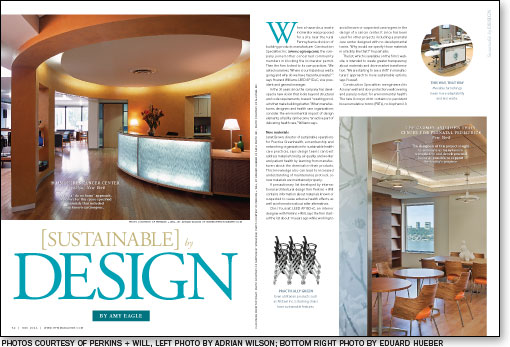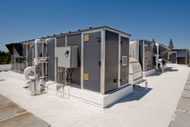Sustainable by design (PDF)
When a hazardous waste incinerator was proposed for a site near the rural Pennsylvania division of building products manufacturer Construction Specialties Inc. (www.c-sgroup.com), the company joined other concerned community members in blocking the incinerator permit. Then the firm looked to its own practices. "We asked ourselves, 'Where is our hazardous waste going, and why do we have hazardous waste?'" says Howard Williams, LEED AP ID+C, vice president and general manager.
In the 20 years since, the company has developed a new vision that looks beyond structural and code requirements, toward "creating products that make buildings better." When manufacturers, designers and health care organizations consider the environmental impact of design elements, a facility can become "an active part of delivering health care," Williams says.
New materials
Janet Brown, director of sustainable operations for Practice Greenhealth, a membership and networking organization for sustainable health care practices, says design teams can best address material toxicity, air quality and worker and patient health by learning from manufacturers about the chemicals in their products. This knowledge also can lead to increased understanding of maintenance protocol, so new materials are maintained properly.
A precautionary list developed by international architectural design firm Perkins + Will contains information about materials known or suspected to cause adverse health effects, as well as information about safer alternatives.
Chris Youssef, LEED AP BD+C, an interior designer with Perkins + Will, says the firm started the list about 10 years ago while working to avoid known or suspected carcinogens in the design of a cancer center. It since has been used for other projects, including a prenatal care center designed with no developmental toxins. "Why would we specify those materials in a facility like that?" Youssef asks.
The list, which is available on the firm's website, is intended to create greater transparency about materials and drive market transformation. "We are starting to see a shift" in manufacturers' approach to more sustainable options, says Youssef.
Construction Specialties reengineered its Acrovyn wall and door protection, wallcovering and panel product for environmental health. The new Acrovyn 4000 contains no persistent bioaccumulative toxins (PBTs), no bisphenol A (BPA) and no halogenated fire retardants. It is completely recyclable, and its materials and manufacturing process are Cradle-to-Cradle Gold-certified by McDonough Braungart Design Chemistry (MBDC), a global sustainability consulting and product certification firm.
Handrails, crash rails, corner guards and sheet wall protection from Alpar Architectural Products LLC (www.alpararch.com), Minneapolis, also have no PBTs, BPA or halogenated fire retardants. They are petroleum-free, made from recycled, recyclable or rapidly renewable materials. Alpar uses aluminum, stainless steel and deTerra, a 90 percent biobased polymer that even can be composted. Lisa Britton, CSI, CCPR, LEED AP BD+C, president, Alpar, says deTerra looks and feels like other polymers, but is somewhat more rigid and scratch resistant than polyvinyl chloride (PVC) and available alternatives.
Sustainable furnishings
Interior design and planning firm Gallun Snow Associates Inc., Denver, has established a specification process for sustainable furnishings that has garnered several projects Leadership in Energy and Environmental Design (LEED) credits from the U.S. Green Building Council. The criteria include information about the material used to make a product, such as its impact on indoor air quality and its percentage of recycled content; a life-cycle assessment, which considers qualities like a product's warranty and its adaptability to future uses; and an analysis of the manufacturer's commitment to sustainability, as evidenced by responsible waste management, packing and shipping processes and the availability of a take-back or refurbishment program.
Margie Snow, AAHID, ASID, IIDA, LEED AP, principal, Gallun Snow, says when the firm started asking these questions in 2004, "most manufacturers didn't know what we were talking about." Now, many companies are having their products tested by independent environmental standards groups. Herman Miller Inc. (www.hermanmiller.com), Zeeland, Mich., Allsteel Inc. (www.allsteeloffice.com), Muscatine, Iowa, and Knoll Inc. (www.knoll.com), East Greenville, Pa., are among the manufacturers who use third-party certification.
Anita Rossen, senior health care interior designer and associate partner at the Seattle office of Zimmer Gunsul Frasca Architects (ZGF), says manufacturers have made great strides in developing furnishings for maximum efficiency and flexibility and reduced waste, now and in the future. "The Number 1 driver of waste in health care is change," Rossen says. ZGF's design of Seattle Children's Hospital uses walls and furnishings that can be rearranged as needed to enable the hospital to take an operationally driven, holistic approach to sustainability that allows for continuous improvement.
Demountable walls and systems furniture lines, such as those by Steelcase (www.steelcase.com), Grand Rapids, Mich., and KI (www.ki.com), Green Bay, Wis., reduce materials and construction waste. The latest products "support health care specifically — they weren't designed for another market," Rossen notes.
Managing waste streams
Waste management is another essential part of a facility's environmental performance that must be considered in its design. The Smart Sink, by Cactus LLC (www.cactusllc.net), Charleston, S.C., is a new product developed to manage raw pharmaceutical waste in an environmentally responsible manner. It is essentially "a sink without a drain," says Dave Maness, CEO and founder, Cactus. The product, which can be securely installed wherever needed, renders pills, patches and liquids unusable and unrecoverable, and securely stores the wasted drugs so they pose no harm to the environment.
For recyclable materials, the appropriate placement and design of recycling containers is important. "The right containers in the right place with the right signage," can improve participation in recycling programs, says Deb Gillmeister, director of marketing, health care services division, Stericycle (www.stericycle.com), Lake Forest, Ill.
Designers should allow enough space in such key locations as break rooms, lobbies and cafeterias for recycling containers next to solid waste containers. "People want to do the right thing, but the room may not be there," says Ed Barr, CHESP, program manager, health care services division, Stericycle.
Linda Lee, DRPh, REM, vice president, director of operations, WM Healthcare Solutions Inc., a subsidiary of Waste Management Inc. (www.wm.com), Houston, agrees. "People in health care are interested in public health. They want to recycle, but if you don't make it convenient, they're just going to look for the trash receptacle." Lee says WM Healthcare Solutions will work with hospitals to meet their needs, including adding logos or branded sustainability messages to recycling containers. "We really try to fit the design," she says.






